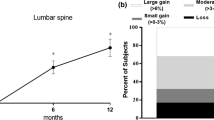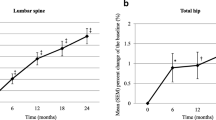Abstract
Summary
Previous reports demonstrated that bone density decreased rapidly during the initial few months of steroid therapy and continued decreasing at a rate of 2 to 4% annually. Our data indicates that denosumab can also play a role in the treatment of osteoporosis in the steroid-taking population.
Introduction
Respiratory physicians are often faced with the dilemma that long-term steroid use will deteriorate bone mineral density and quality. Previous reports demonstrated that bone density decreased 8 to 12% during the initial few months of steroid therapy then continued decreasing at a rate of 2 to 4% annually. Several prospective trials revealed that denosumab increased bone density in patients with osteoporosis [2–4] and decreased the rate of occurrence of fractures. The long-term efficacy of denosumab for glucocorticoid-induced osteoporosis, however, has not yet been proven.
Materials
This has been an ongoing prospective study since 2014. In our respiratory centre, the first preventative measure used to combat glucocorticoid-induced osteoporosis (GIO) is oral bisphosphonates. Thirty-six patients were enlisted, and their treatment courses were changed from oral bisphosphonate, if administered, to the subcutaneous injection of denosumab 60 mg every 6 months, combined with a daily oral intake of DENOTAS® chewable combination tablets. The primary efficacy measures were changes in lumbar spine (LS) bone mineral density (BMD) and femoral BMD from baseline at 4, 8, 12 and 28 months.
Results
At the 12-month follow-up, bone mineral density in the lumbar spine area of these patients increased by 3.2%, while bone mineral density in the hip area showed no significant increase. At the 28-month follow-up, 25 patients were still included in this study. Femoral BMD at 28 months increased significantly from the 12-month follow-up (P = 0.0259), though the first 12 months showed no significant increase. LS BMD continued to increase through the 28-month period.
Conclusions
Very little is known regarding the active prevention of GIO. Our data indicates that denosumab can play a promising role in the treatment of GIO.



Similar content being viewed by others
References
LoCascio V, Bonucci E, Imbimbo B, Ballanti P, Adami S, Milani S, Tartarotti D, DellaRocca C (1990) Bone loss in response to long-term glucocorticoid therapy. Bone Miner 8:39–51
Brown JP, Prince RL, Deal C et al (2009) Comparison of the effect of denosumab and alendronate on BMD and biochemical markers of bone turnover in postmenopausal women with low bone mass: a randomized, blinded, phase 3 trial. J Bone Miner Res 24:153–161
Kendler DL, Roux C, Benhamou CL, Brown JP, Lillestol M, Siddhanti S, Man HS, San Martin J, Bone HG (2010) Effects of denosumab on bone mineral density and bone turnover in postmenopausal women transitioning from alendronate therapy. J Bone Miner Res 25:72–81
Nakamura T, Matsumoto T, Sugimoto T et al (2014) Clinical Trials Express: fracture risk reduction with denosumab in Japanese postmenopausal women and men with osteoporosis: denosumab fracture intervention randomized placebo controlled trial (DIRECT). J Clin Endocrinol Metab 99:2599–2607
von Keyserlingk C, Hopkins R, Anastasilakis A, Toulis K, Goeree R, Tarride JE, Xie F (2011) Clinical efficacy and safety of denosumab in postmenopausal women with low bone mineral density and osteoporosis: a meta-analysis. Semin Arthritis Rheum 41:178–186
Mazziotti G, Formenti AM, Adler RA, Bilezikian JP, Grossman A, Sbardella E, Minisola S, Giustina A (2016) Glucocorticoid-induced osteoporosis: pathophysiological role of GH/IGF-I and PTH/VITAMIN D axes, treatment options and guidelines. Endocrine 54(3):603–611
Suzuki Y (2015) On “2015 Guidelines for Prevention and Treatment of Osteoporosis”. Drug-induced osteoporosis: glucocorticoid-induced osteoporosis. Clin Calcium 25:1347–1356
Venuturupalli SR, Sacks W (2013) Review of new guidelines for the management of glucocorticoid induced osteoporosis. Curr Osteoporos Rep 11:357–364
Lekamwasam S, Adachi JD, Agnusdei D et al (2012) A framework for the development of guidelines for the management of glucocorticoid-induced osteoporosis. Osteoporos Int 23:2257–2276
Suzuki Y (2014) Glucocorticoid and bone. Updated Japanese guidelines for the management of glucocorticoid-induced osteoporosis. Clin Calcium 24:1309–1318
Mok CC, Ho LY, Ma KM (2015) Switching of oral bisphosphonates to denosumab in chronic glucocorticoid users: a 12-month randomized controlled trial. Bone 75:222–228
Niimi R, Kono T, Nishihara A, Hasegawa M, Matsumine A, Kono T, Sudo A (2014) Determinants associated with bone mineral density increase in response to daily teriparatide treatment in patients with osteoporosis. Bone 66:26–30
Niimi R, Kono T, Nishihara A, Hasegawa M, Matsumine A, Nakamura T, Kono T, Sudo A (2014) An algorithm using the early changes in PINP to predict the future BMD response for patients treated with daily teriparatide. Osteoporos Int 25:377–384
Yoshiki F, Nishikawa A, Taketsuna M, Kajimoto K, Enomoto H (2017) Efficacy and safety of teriparatide in bisphosphonate-pretreated and treatment-naive patients with osteoporosis at high risk of fracture: Post hoc analysis of a prospective observational study. J Orthop Sci 22(2):330–338
Cosman F, Nieves JW, Dempster DW (2017) Treatment sequence matters: anabolic and antiresorptive therapy for osteoporosis. J Bone Miner Res 32:198–202
Whitmarsh T, Treece GM, Gee AH, Poole KE (2015) Mapping bone changes at the proximal femoral cortex of postmenopausal women in response to alendronate and teriparatide alone, combined or sequentially. J Bone Miner Res 30:1309–1318
Author information
Authors and Affiliations
Corresponding author
Ethics declarations
Conflict of interest
None.
Rights and permissions
About this article
Cite this article
Ishiguro, S., Ito, K., Nakagawa, S. et al. The clinical benefits of denosumab for prophylaxis of steroid-induced osteoporosis in patients with pulmonary disease. Arch Osteoporos 12, 44 (2017). https://doi.org/10.1007/s11657-017-0336-1
Received:
Accepted:
Published:
DOI: https://doi.org/10.1007/s11657-017-0336-1




